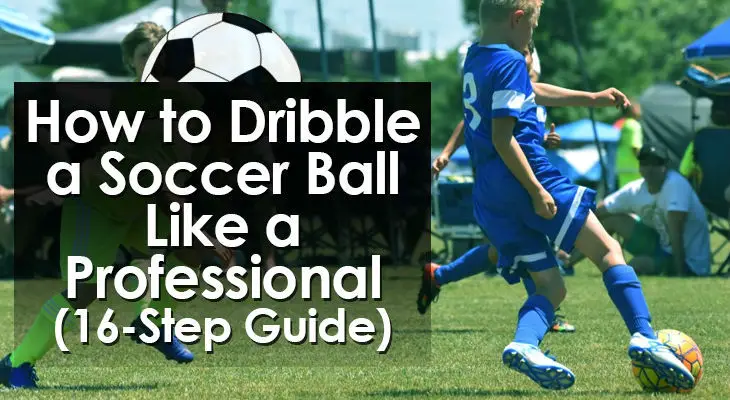How to Dribble a Soccer Ball (Advanced 16-Step Guide)
Imagine effortlessly dribbling past the opposition players…
Weaving your way amongst tightly packed defenders before sending the ball past the keeper and into the back of the net with a smooth kick.
Some of the most stunning goals are set up just like this.
Learning how to dribble a soccer ball with speed and control is a valuable skill that will help you get out of many tight spots on the pitch.
It will also help you win more time and space to pop off a quick shot or make a difficult pass.
So, what’s the best way to learn how to dribble a soccer ball?
What are some of the best tips and tricks to help you develop your dribbling?
Here’s a 16-step guide to help you out...
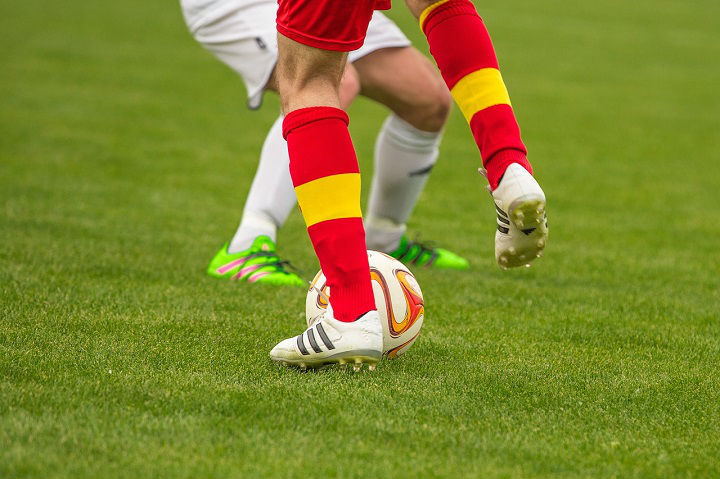
How to Dribble a Soccer Ball
Before pulling off Cruyff turns, stepovers, and nutmegs, you're going to want to start with the basics and make sure that you are comfortable with the ball at your feet.
Here we’ll talk about how to start off dribbling.
- The key things to remember are:
- Focus on your ball control.
- Focus on your pace and balance.
- Keep your head up.
Dribbling is used to gain yourself more time and space or to get past an opponent without them taking the ball away from you.
Step #1: Make Frequent Small Touches of the Ball
When dribbling, taking frequent small touches will give you more control over the ball.
You’ll be able to change direction quicker or pull off a dribbling move immediately that will enable you to get by your opponent.
It also makes it harder for defenders to read what you’re going to do which makes it difficult for them to judge when to put in a challenge on the ball.
While this is quite tough to do well in the beginning, with practice your speed and confidence with the ball will dramatically improve.
Step #2: Don’t Let the Ball Get Too Far Away
By keeping the ball close to your feet, it’s much easier to quickly react to any challenge that comes your way from opposition players.
To help with this control, keep your knees slightly bent as you move the ball from one foot to the other.
By staying low, you’ll also be able to change directions faster.
The only time you want to push the ball out in front of you is when you’re sure you have space and time to get to it before a tackle comes in.
Step #3: When Running, Push the Ball Forward With the Outside of Your Foot
When advancing up the pitch with the ball, you want to have your dominant foot out in front of you each time you pace forwards.
The laces of your dominant foot should regularly tap the ball forward as you use the same foot each time.
This makes it easier to control the ball at a sprint.
You’ll also have better control of your speed and balance.
It should almost look like the ball is glued to your dominant foot when you’re pushing it forward quickly with regular small touches.
Step #4: Keep Your Head Up as Much as Possible
Easier said than done…
As we all know, players will naturally stare down at the ball when they’re first learning how to dribble a soccer ball.
The problem with this is that players won’t be able to see defenders in their way.
Taking frequent looks ahead will allow a player to keep control of the ball while still knowing where the opposition players are on the pitch.
It will also make it easier to see teammates darting forward or potential goal scoring opportunities when they present themselves.
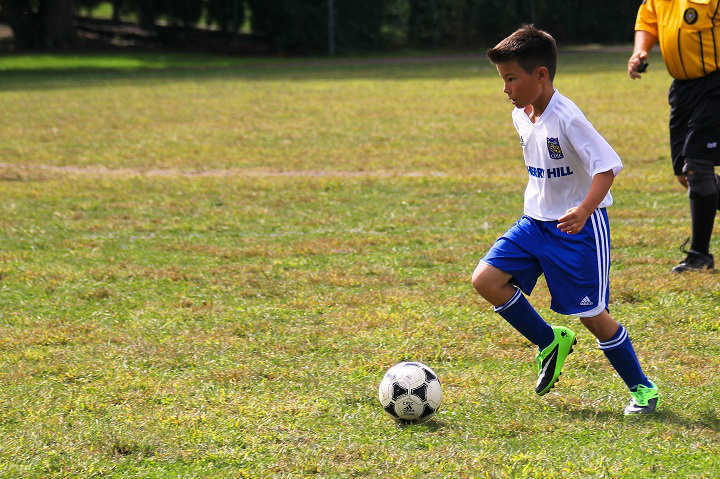
Step #5: Change Up Your Dribbling Speed
One of the easiest ways to make your dribbling unpredictable is to frequently mix up your running speed with the ball at your feet.
If you dribble at the same pace all the time, it’s much easier for defenders to challenge you knowing they’re likely going to win the ball fairly.
To make yourself difficult to play against, you need to practice dribbling at different speed and varying up how often you touch the ball.
By occasionally hitting the ball ahead, you can evade a defender by knocking the ball past their challenge before picking it up again on the other side of them.
Step #6: Protect the Ball With Your Body
A great way to make sure that you retain possession of the ball (or at the very least draw a foul) is to use your body to shield the ball from your opponent.
Position yourself so that the opposition player is as far away from the ball as possible.
While trying to always keep them at arm’s length, you can also hold them off with your body strength as you use your feet to keep moving the ball away from them.
Step #7: Always Keep Your Balance
To keep your balance while dribbling, you always want to keep your arms out a bit and your knees slightly bent.
Doing so will lower your centre of gravity and you’ll be able to power away from your opponent.
To add to this, always land on the front of your feet (not the heels) as this will give your more explosive power and will improve your balance.
Step #8: Find an Open Space to Practice
One of the first things you should do is practice the technique of sprinting with the ball.
Find a large open space where you can practice sprinting back and forth, taking small frequent touches with the laces of your boot to push the ball forwards.
Make sure that the ball doesn't end up too far out in front of you and that you push the ball forward each time you advance with your dominant foot.
And remember…
Practice this with both feet so that you are confident dribbling with the ball in any situation.
Try and go as fast as possible while still remaining in control of the ball.
Step #9: Get Some Cones!
Now, let’s practice changing direction...
Cones will allow you to practice weaving around your opponent while keeping the ball close to you and under control at all times.
Cones are a great way to allow you to practice when there aren’t any teammates around.
To start off simple, set up cones in a straight line and practice dribbling in and out of them with one foot at a time.
Make sure to leave enough space between the cones that you can dribble in and out of them without too much difficulty.
If you find yourself knocking the cones over, slow down and concentrate on controlling the ball.
Start off with your dominant foot and alternate between using the laces on your boot and the interior of your foot to dribble around the cones.
Once you get to the end, turn around and use your weaker foot to come back.
You need to master dribbling with both feet!
Extra Resource: 10 Soccer Ball Control and Footwork Drills to Do at Home
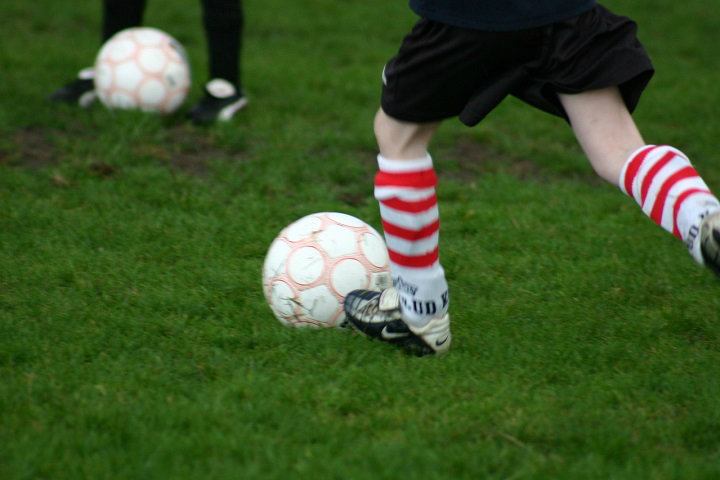
Step #10: Practice Alone or With a Friend
While cones are useful, they’re not 100% necessary to improve your dribbling ability.
Another fantastic way to improve your ball control is to simply pass the ball between your feet without moving around too much.
This is perfect for practicing in the backyard or in an area where you don’t have much space.
By using small touches to flock the ball from foot-to-foot, you’ll improve your feeling and touch for the soccer ball.
And if you have a friend to practice with…
You can both attempt to evade the other’s tackle and use your tricks to pass each other.
As well as being great fun, it will also improve your defensive skills as well as your dribbling skills.
Now that we’ve looked at the technique involved and given you a few tips to use when learning how to dribble a soccer ball, let’s go over a few specific drills you can use to practice….
Step #11: Drill - Cone Cluster
How the Drill Works:
The player works for 45-seconds dribbling in and out of the cone cluster.
Purpose:
Quick set up that develops a player’s creativity and feet in a tight space. The player must think fast and freely to move throughout the cone cluster without hitting the cones.
Setup:
• Randomly set up at least 10 cones, or objects in a circular shape. Add as many cones or objects as desired. Vary the distances and angles between the cones. See diagram.
• One soccer ball is needed.
• Player starts outside the cone cluster.
• Complete as many 45-second rounds as needed. Change the dribbling rules and cone placements between rounds to mix it up.
Instructions:
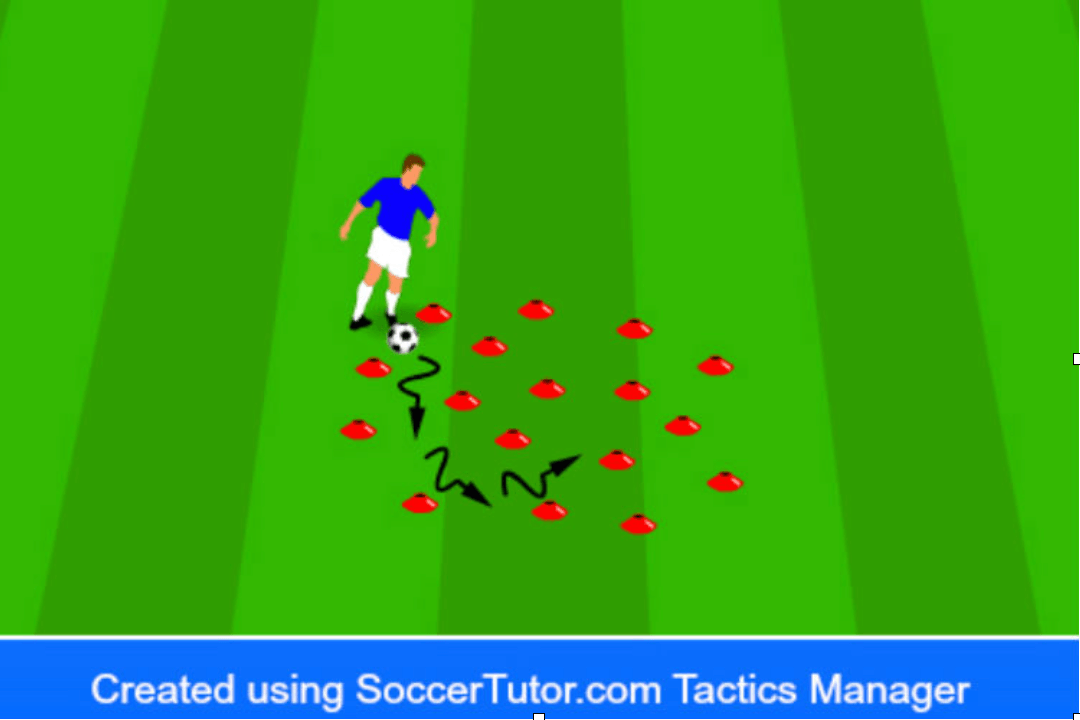
1. A player works for 45-second rounds dribbling, freely, through the cone cluster. The player can dribble outside the cluster but should try to stay in the group of cones as long as possible.
2. A player uses changes of direction and speed to navigate the tight spaces in the cluster.
3. Start slow and increase the intensity of each round as the player improves.
4. Add new variations and patterns between rounds. Complete as many rounds as desired.
Variations:
Dribbling Patterns – Only right, only left, only insides, only outsides, only bottoms, etc. Any pattern works if it is challenging.
Challenging Patterns – Be creative. Give challenging patterns that are difficult to accomplish in the first attempt.
Coaching Points:
• Teach the player to use all parts of their feet and to work on certain moves and changes of direction that they use in games.
• Remind the player to dribble with their head up, when possible, to see the field and build good team habits.
• Encourage the players to take small, quick touches to get around the cones! How many do they hit each round?
Step #12: Drill - Two Gate Dribbling
How the Drill Works:
Player sets up two, four-yard wide gates, 10 yards away from each other and dribbles between the two gates using sharp changes of direction.
Purpose:
Easy setup that allows a player to develop their ability to use cuts and turns to change direction quickly and dribble in the opposite direction.
Setup:
• Set up two, four-yard wide gates, at least 10 yards away from each other. See diagram.
• One soccer ball is needed.
• Player starts between one gate.
• Complete as many 40-second rounds as needed. Change the turn or dribbling variation between rounds!
Instructions:
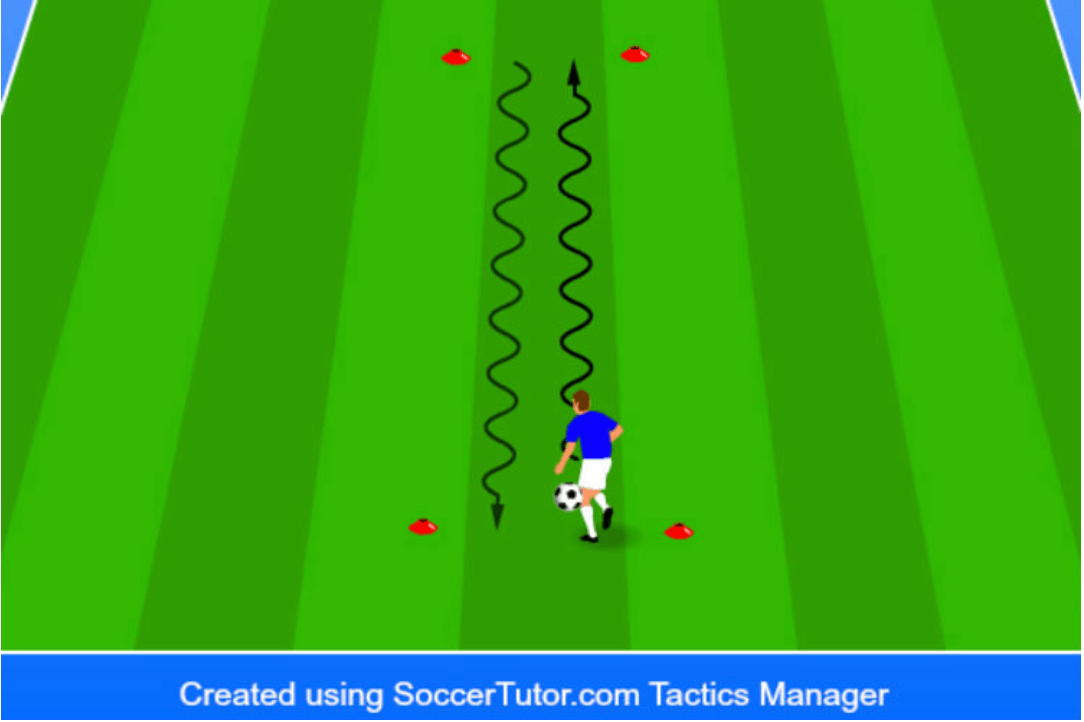
1. Player dribbles between the two gates and performs a cut or turn at every time they get to a gate.
2. Start slow and then increase their dribbling speed as changes of direction improve.
3. Complete as many 40-seconds rounds as required. Make sure to rest between rounds. Add a new variation or pattern as needed.
Variations:
Gate distance – Adjust the distance between the two gates.
Cuts – Inside, outside, Cruyff, squash, etc. Switch the turn variation to develop multiple turns.
Dribbling patterns – Only right, only left, only insides, only outsides, only bottoms, etc. Any pattern works if it is challenging.
Challenging patterns – Be creative. Give challenging patterns that are difficult to accomplish in the first attempt.
Coaching Points:
• Teach the player different cuts or changes of directions that they can perform at the gates. Have the player become excellent at three or four instead of being ok at 10.
• Encourage the player to accelerate after each change of direction! Make it game-like and get away from the defenders!
• Remind the player to look up when dribbling to build good habits.
• Can we go faster? Can we challenge ourselves to perform the activity at a higher speed to make it more game-like?
Step #13: Drill - Zig Zag Dribbling
How the Drill Works:
With just a few cones, or objects, players zig-zag their way through the cones using different parts of the feet!
Purpose:
Simple and effective activity that develops a player’s ball control. New to advanced players can all benefit from this exercise.
Setup:
• Set up as many cones, or objects, in a line to dribble through. Four to 10 cones are suggested. Cones should be less than one yard apart.
• One soccer ball is needed.
• Complete as many patterns and touches as needed!
Instructions:
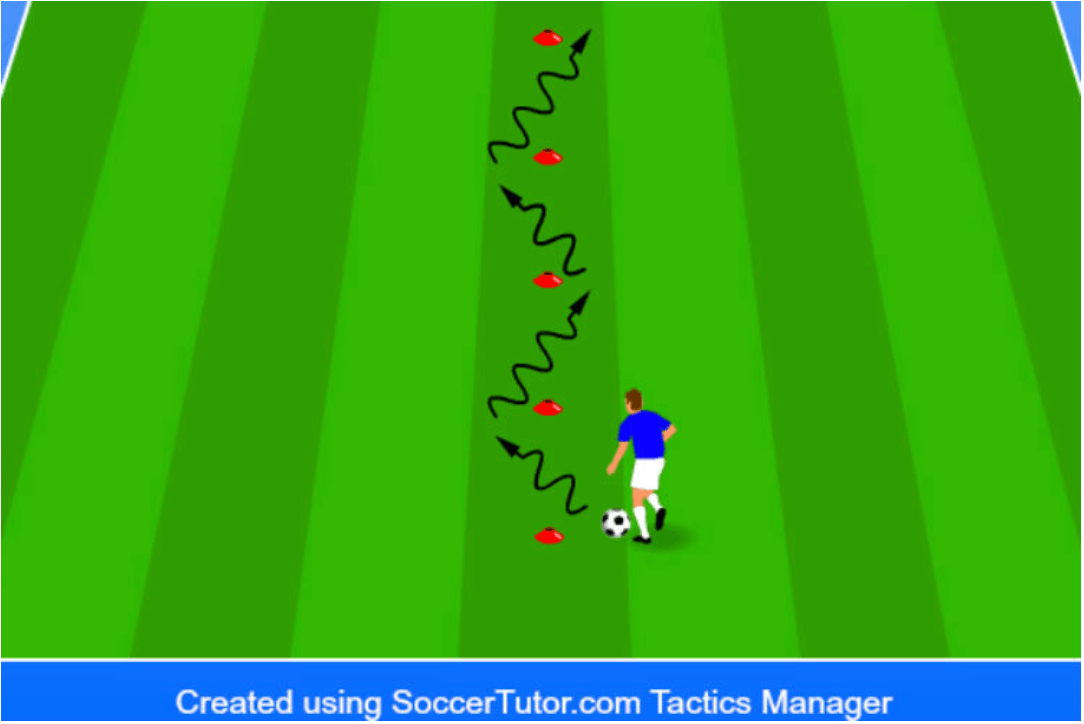
1. Player dribbles through the cone line in a zig-zag pattern attempting to miss each cone.
2. Start slow and then increase their speed as they improve.
3. Vary the dribbling pattern: insides only, outsides only, all right, all left, bottoms only, etc. Player should become comfortable at using all surfaces of their feet!
4. Complete as many patterns and touches as needed!
Variations:
Cone distance – Adjust the space between cones to increase or decrease the difficulty.
Challenging patterns – Be creative. Give challenging patterns that are difficult to accomplish in the first attempt.
Coaching Points:
• Lots of quick, soft touches through the cones!
• Can we look up when we dribble?
• Can we go faster as we become more comfortable with the patterns? Challenge yourself!
3 Fancy Soccer Tricks to Master
When you find yourself in a tight situation out on the pitch, sometimes you’ll need that extra bit of magic to get past your defenders and into open space.
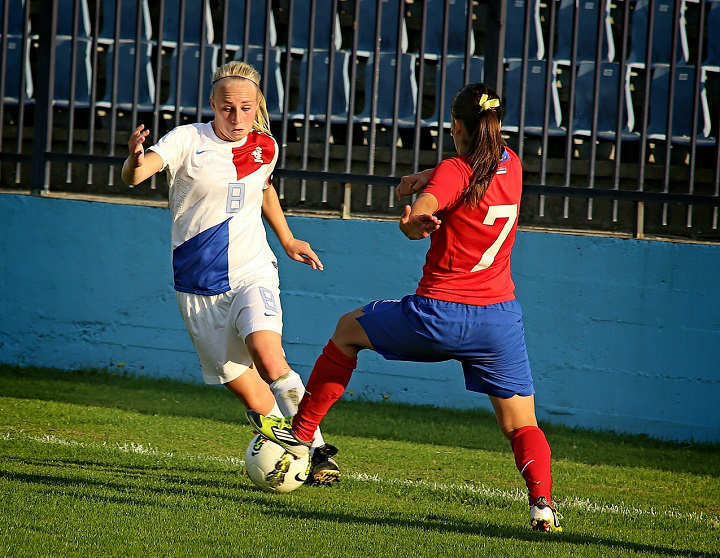
Here are a few dribbling skills to practice:
Step #14: The Step-Over
One of the keys to dribbling is to sell your opponent a dummy to throw them off balance so that you can dribble past them.
The step-over is one of the skills that can achieve this.
The blur of your legs around the ball makes it hard for your defender to know when and where they should make a challenge.
To successfully do a step-over, you want to throw your foot at the ball to make it look as if you’re going to take the ball to one side of you…
But instead of actually touching it, you loop your foot over and around the ball, selling the feint with your body movement before taking the ball in the opposite direction with the outside of your other foot.
When perfected, this will completely baffle defenders.
Once you’re confident with this move, you can perform several step-overs above the ball before finally deciding on a direction you want to dribble the ball.
Step #15: The Nutmeg
Want to humiliate and embarrass your opponent?
Then the nutmeg is for you.
It involves putting the ball between your defenders legs and then sprinting on to retrieve the ball in open space.
If performed correctly, it can help you get around your opponent and leave them apprehensive about putting in a challenge next time you come face-to-face.
To do it, you want to position the soccer ball between you and your opponent and you want to make them think that they’ll get to the ball first.
When the reach their foot out to strip you of the ball, you tap the ball to slip it between the opponent’s legs and out into open space.
From there, you can run past them to gain possession of the ball as they’re left flat-footed and embarrassed.
Step #16: The Cruyff Turn
A famous move by one of the all-time greats of the game, Johan Cruyff.
This is one of the most impressive moves to pull off.
Making it look as if you’re about to shoot, you want to line your body up as if you’re about to kick the ball before dragging the ball back behind your standing leg.
The defender will attempt to block the shot and is now stuck out of position and off balance.
This allows you to drive past them and towards goal to take a shot or set up a teammate.
Click here to see how it works.
Conclusion
Learning how to dribble a soccer ball at an elite level is one of the most important things a young player can spend their time working on.
Doing so will give you a massive advantage over your opponents on game day.
All it takes is one sneaky dribbling move or a clever change of pace to get past your opponent and into open space to score or pass to an open teammate.
This is a potentially game-deciding play.
The 16 steps above provides you with all the tools you need to develop into a player who can take the opposition on whenever you want.
Once you spend enough time practicing, you’ll have the confidence to do it.

